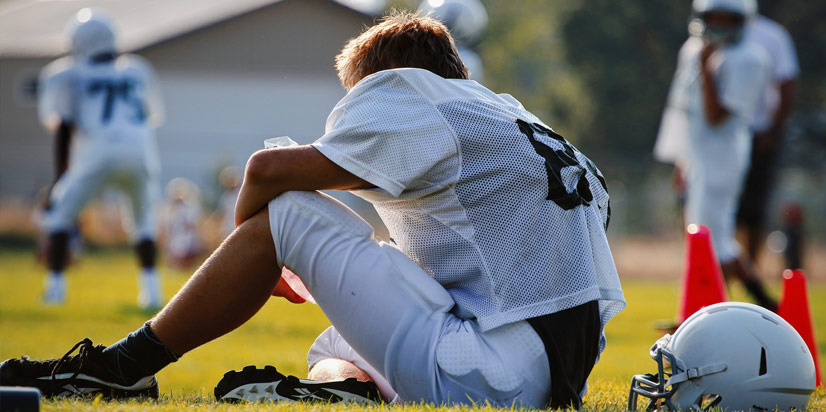
The kids are back in school and many are on the athletic fields playing sports. Unfortunately, at this time of the year, we see a stream of sports injuries as young athletes jump head-first into daily practices and games, in many cases following a summer of inactivity. With weakened muscles, they are susceptible to muscle strains, sprained joints and bone fractures that could sideline them for weeks and lead to permanent damage.
In the U.S., more than 3.5 million children under age 14 receive medical treatment for sports-related injuries every year, and high school athletes account for about two million injuries, 500,000 doctor visits and 30,000 hospitalizations, according to the National SAFE KIDS Campaign.
What’s a parent to do when they see their enthusiastic child risking injury by overexerting him or herself, or even ignoring injuries so they can continue to play? Here are some tips on how to make sure your child stays healthy throughout the season.
- Communication. Talk to your child and make sure he or she understands that if something doesn’t feel right, it’s time to investigate. The old credo of playing through injuries and “toughing it out” should not be part of their vocabulary.
- Make sure your child had a preseason physical. You need to be confident that your child is fit to play. Physicals help assess areas of concern before athletes hit the field and also prevent them from further injuring themselves. These are almost always mandatory when a child is playing a school sport, no matter what season.
- Stress the importance of staying hydrated. Many injuries occur when fatigue sets in and the athlete becomes dehydrated. And remember, waiting until you feel thirsty is often too late when practicing because thirst is a sign of dehydration.
- Drink up to 20 fluid ounces two to three hours before practice.
- Drink 8-10 ounces 15 minutes before practice.
- Drink 8-10 ounces every 15 minutes during practice.
- Drink plenty after practice, up to 24 ounces of water for every one pound lost due to sweating.
- Develop a regular stretching routine. Stretching keeps a body flexible and allows for a full range of motion. A pre-workout stretching routine is also a good warmup for the body.
Even with these safeguards, injuries will occur, and your child might not tell you. In some cases, children might not recognize the symptoms of an injury. Here are tips for parents on how to spot when it’s time for their child to take a step back, head to the sideline and, if necessary, see their primary care doctor.
- Understand burnout. If your child seems exhausted or is unable to recover fully from workouts, he or she may be injured or training too hard. Other signs of burnout include your child losing interest in a sport they enjoyed, being depressed, tired, having trouble sleeping and experiencing mood swings.
- Keep a close eye on your child at home. Look for signs of an injury that will worsen if the athlete doesn’t take a step back:
- The child complains that muscles feel sore and legs feel heavy.
- He or she limps or feels pain when putting weight on a particular part of the body.
- There is tingling or numbness in the limbs, fingers or toes.
It is difficult to limit your child’s activity when he or she is playing a school sport where practices are determined by the coach, but you can make sure your child gets proper rest at other times. For children who are serious about sports, it is important to have one full day of rest per week. Athletes are at a much higher risk of injury when they are fatigued.
- Watch for overuse injuries. Be aware of the signs of overuse injuries that are caused by repetitive actions and put too much stress on bones and muscles:
- Your child feels tenderness in the elbow when throwing a ball.
- A knee is sore and swollen.
- There is pain in the back of the shoulder.
- There is discomfort in the front and lower parts of the legs when running.
- The lower back feels tight.
These injuries will worsen if not given time to heal. As a parent, watch for pain that cannot be tied to an acute injury, as well as swelling and changes in the child’s form or technique. Many young athletes will attempt to play through tendinitis, shin splints and anterior knee pain, but that’s when you as a parent need to step in and insist on rest.
- Preach patience. Athletes are at a much greater risk of reinjury when they return too soon. By doing so, they place stress on the injury and force the body to compensate for the weakness, which often leads to a new injury in another part of the body. No child wants to be sidelined, but taking time off can actually result in a healthier athlete in the long term.
Student-athletes are usually more concerned about playing time or losing their spot in the lineup, and thus often decide to “play through the pain.” Therefore, it’s essential that parents quickly identify signs of possible injuries that are not always obvious and step in to prevent further damage.
Need to schedule a physical for your child for their next sports season?
Click here to schedule online.

